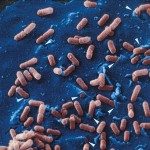Lien vers Pubmed [PMID] – 18755008
J Microsc 2008 Sep;231(3):524-8
How invasive bacteria exploit mammalian host cell components to induce their entry into cells has received a lot of attention in the last two decades. Model organisms have emerged and helped understanding the various mechanisms that are used. Among those, Listeria monocytogenes is one of the most documented organisms. It enters into cells via two bacterial proteins, internalin (also called InlA) and InlB, which interact with cell surface receptors, E-cadherin and the hepatocyte growth factor receptor, Met, respectively. These interactions initiate a series of events that leads to actin polymerization, membrane invagination and bacterial internalization. Investigations on internalin- and InlB-mediated entries have repeatedly shown that Listeria fully usurps the host cell machinery. Moreover, they have also shown that previously unknown components discovered during the study of Listeria invasion play a role either in E-cadherin-mediated cell-cell adhesion or Met signalling. Unexpectedly, recent studies have highlighted a role for clathrin in Listeria InlB-mediated actin polymerization and entry, revealing a new role for this endocytic protein, i.e. in bacterial-induced internalization. Furthermore, comparative studies have demonstrated that the clathrin-mediated endocytosis machinery is also used in the internalin-E-cadherin pathway, and for the entry of other bacteria that enter by a ‘zipper’ mechanism. By contrast, the clathrin-mediated endocytic machinery is not used by bacteria that inject effectors into mammalian cells via the type III secretion system and enter by the so-called trigger mechanism, characterized by enormous membrane ruflles that result in the macropinocytosis of the corresponding bacteria. Finally, adherent bacteria, for example enteropathogenic Escherichia coli (EPEC), also co-opt clathrin to induce the formation of actin-rich pedestals. Together, these new data illuminate our view on how actin rearrangements may be coupled to clathrin recruitment during bacterial infection. They also shed light on a new function for clathrin in mammalian cells, i.e. internalization of objects much larger than previously accepted.

